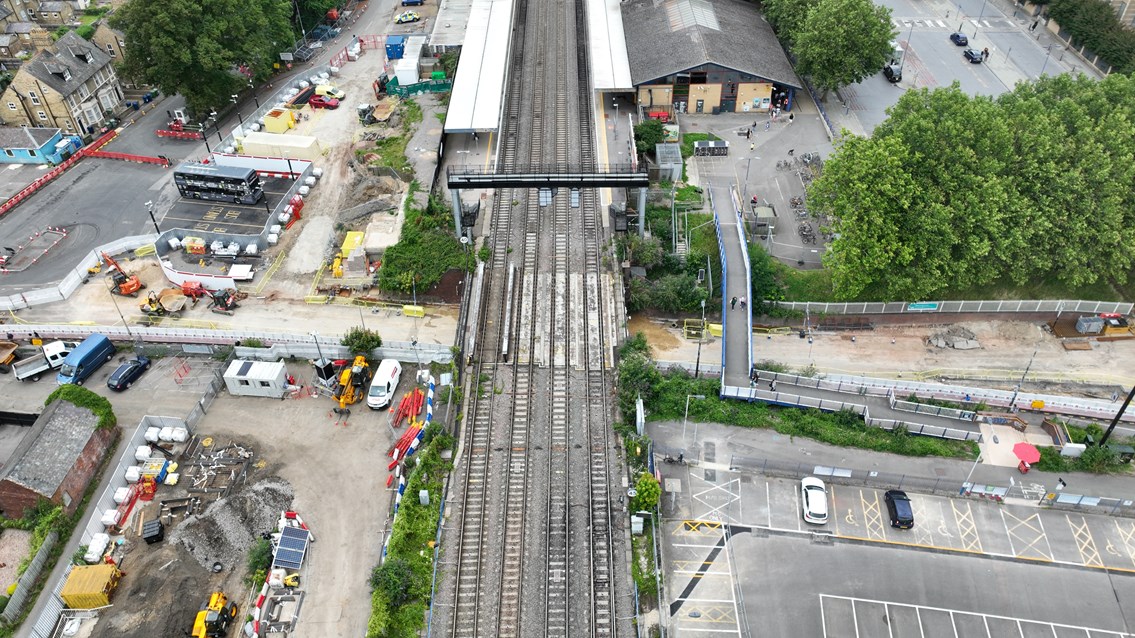Thursday 17 Aug 2023
Network Rail extends working hours on Oxford station upgrade to compensate for delay caused by historic discoveries
- Region & Route:
- Wales & Western
- | Wales & Western: Western
A Victorian brick archway and a hand grenade are among some of the unique challenges that temporarily paused progress on the major project, with round the clock shifts now set to begin.
Work on the £161m Oxford station and railway upgrade had to be paused in June, after contractors unearthed an inverted brick arch under the road at Botley Road bridge.
Ground investigations have since revealed the historic arch is far larger than previously known - reaching a metre deep and stretching around 100 metres - the full length between Mill Street and Frideswide Square.
Archaeologists believe the arch is part of a Victorian water system, designed to keep river water away from the railway and city.
A new work schedule has had to be drawn up to safely remove the brick arch before Network Rail and contractors, Kier Group, can continue to divert the utilities below Botley Road. This will involve the installation of piles to support the bridge and a switch to 24/7 working hours. During this work, a temporary drainage system will be in place to manage groundwater, before a new permanent pumping system is installed later in the project.
From the week commencing Monday 14 August, the team on site will be working from 7am until 7pm, seven days a week. Starting on Saturday 2 September, around the clock work will be carried out on site. To reduce disturbance to those in the area, the nosiest work will be carried out during the day. This revised approach has been agreed with Oxford City Council, in consultation with Oxfordshire County Council.
The multi-million-pound project to upgrade the station, the railway and the surrounding local road network will boost passengers’ travel experience whilst better connecting rail links to the East of Oxford. Once complete, the station and railway upgrades - part of the Oxfordshire Connect programme – will provide travellers with a bigger and better Oxford station and an expanded railway which will enable more services for passengers and freight, with reduced journey times.
The road network near the station will also be improved, with safer junctions with Botley Road and more opportunities for sustainable transport, including enhanced bus travel as well as more space for cyclists and pedestrians through the addition of a four-metre cycle and footway on each side of the main road.
Philip Morton, project manager at Network Rail said: "Whilst we knew the arch was there, it’s much larger than our original ground surveys identified, which has added a unique layer of complexity to our ongoing work to upgrade of Oxford station and surrounding areas.
“Due to its potential significance in supporting the bridge, removing the arch from beneath Botley Road is now our biggest challenge, but we’re addressing it as safely and efficiently as possible.
“Following further investigations, our new work plan involves installing piles to stabilise the bridge while we excavate the brickwork before we can continue to divert the utilities.
“Going forward, we will be working day and night so we can gain back some of the time lost, with the majority of the noisy work planned to take place during the day, to minimise disruption for the local community. As ever, we appreciate everyone’s patience while we manage this unexpected challenge.”
Mark Dodd of Oxford Archaeology, said: "The historic city of Oxford contains archaeological remains dating back to the prehistoric period, so there's always the potential to discover a bit of history beneath the ground.
“Owing to the existing road, the site itself wasn’t an ideal location for archaeology, so the best approach was for us to be on site whilst the works are underway. It’s likely the arch was used to help manage the groundwater owing to its low-lying position close to the river Thames and this is an excellent example of a Victorian engineering solution, as seen elsewhere throughout Britain at this time."
Work was also paused on Thursday 20 July, when a nearby area had to be evacuated following the discovery of a WWII era hand grenade within the work site, near to the railway tracks. Officers from British Transport Police attended the incident, alongside personnel from Explosives Ordinance Disposal.
Notes to Editors
More information, including a library of images and drone footage can be downloaded from this link.
Contact information
Passengers / community members
Network Rail national helpline
03457 11 41 41
Latest travel advice
Please visit National Rail Enquiries
Journalists
Kathy Peart
Media relations manager
Network Rail
kathy.peart@networkrail.co.uk
About Network Rail
We own, operate and develop Britain's railway infrastructure; that's 20,000 miles of track, 30,000 bridges, tunnels and viaducts and the thousands of signals, level crossings and stations. We run 20 of the UK's largest stations while all the others, over 2,500, are run by the country's train operating companies.
Usually, there are almost five million journeys made in the UK and over 600 freight trains run on the network. People depend on Britain's railway for their daily commute, to visit friends and loved ones and to get them home safe every day. Our role is to deliver a safe and reliable railway, so we carefully manage and deliver thousands of projects every year that form part of the multi-billion pound Railway Upgrade Plan, to grow and expand the nation's railway network to respond to the tremendous growth and demand the railway has experienced - a doubling of passenger journeys over the past 20 years.
Follow us on Twitter: @networkrail
Visit our online newsroom: www.networkrailmediacentre.co.uk

